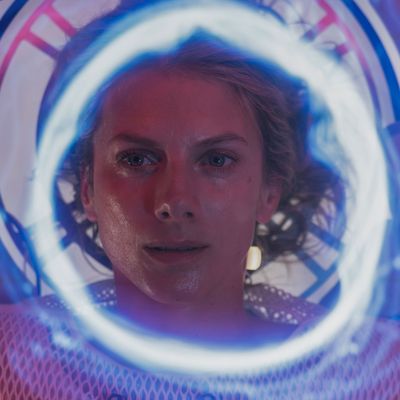
Slosh around in the runoff of Netflix’s lesser releases and you’ll be reminded that the streaming service is as much a data company as an entertainment behemoth. Netflix runs on a schedule of marquee titles, like the Shondaland shows and David Fincher passion projects that are comparable to the output of other major networks and studios. But it is in the steady flow of smaller titles — some of them indie or international acquisitions, some clearly churned out on the cheap — that you can really feel the algorithm at work. Those lower-tier originals provide a (lightly dystopian) glimpse of what people click on when there’s nothing they might actively choose to watch: the meandering true-crime docuseries, the array of increasingly threadbare reality competition shows, the slapdash teen comedies, the high-concept, tight-focus sci-fi films — and man, are there a lot of the latter.
Some are set after an apocalypse: I Am Mother (in which Rose Byrne voices a sinister maternal robot), or IO (Margaret Qualley raises bees on an abandoned Earth), or How It Ends (Theo James crosses the country as it erupts into chaos). Some of them are set on ships: Orbiter 9 (about a woman who is part of a long-term space-travel experiment), or Stowaway (Anna Kendrick & Co. go to Mars), or The Cloverfield Paradox (a Paramount castoff). Most of these movies have minimal casts, which may or may not include name-brand stars. The George Clooney–directed The Midnight Sky was a higher-end production that nevertheless managed to be about both a guy living alone after an apocalypse and some people on a ship. These movies are all over the place in terms of quality and budget, but there is something to the regularity with which they are offered up, and their recurring elements, that becomes haunting. It’s as though the point isn’t a shared genre but something blunter and more calculated: Whose helmeted face can appear in a thumbnail next?
This week, it is actress and filmmaker Mélanie Laurent, whose face appears, in a minor variation, inside the glassed-in environs of a medical cryo unit instead of a suit. She plays Elizabeth Hansen, the main character in Oxygen and the only one who appears onscreen in anything other than a voice-over, a video clip, or a flashback. This French-language film is set far enough into the future that units like the one Elizabeth wakes up in at the start of the film are standard. What throws her into a panic is not that she has woken up swaddled in gauze within the confines of a high-tech casket but that she doesn’t know how she got there, how to get out, or who she is. That’s a lot of information for one immobilized woman to sort out in 90 minutes, especially with the ticking clock of her air running out because the unit sustained some sort of damage. Fortunately for her, the cryo unit comes equipped with some shaky Wi-Fi equivalent and an AI companion who is able to offer help when she asks but who is also inconveniently inclined to sedate and/or euthanize the “bioform” it has been entrusted with.
There’s a twist, though that is such a part of the formula for this type of offering that it can barely be called that. Then there’s another twist to make up for that fact. While both are pretty silly, the second one carries with it all kinds of philosophical implications a more thoughtful film would attempt to explore in some way. Oxygen is not, however, a very thoughtful film, and what should be enormous revelations are moved past easily, Christie LeBlanc’s script operating with the briskness of a project more focused on being a riff on Buried than giving any peripheral sense of a coherent future world. Oxygen was directed by Alexandre Aja, an alum of the New French Extreme who made a name for himself with the transgressive, nonsensical slasher High Tension and who more recently directed the unconscionably fun alligator-attack movie Crawl. His new film may be neither transgressive nor fun, but it is, at least, well crafted, the camera moving limberly to create a sense of visual momentum, even though its protagonist is trapped in a small space. Aja knows what sort of product he is turning out and does it ably, if without much excitement, as though understanding he is filling a hole in a lineup.
It’s actually Laurent, who is too classy to be here, who doesn’t entirely grasp the assignment. She keeps overreaching, giving her cutout character shows of realistic emotion that the film she is appearing in can’t support. It’s entirely plausible that someone in Elizabeth’s situation would have a burst of hysterics, stuck in a claustrophobic setting with death imminent and no rescue in sight. But in the context of Oxygen’s wildly contrived premise, every moment the character takes to feel understandably upset is one in which she is not working to save herself. In pitting her all-too-human reactions against the mechanics of the screenplay, the film invites the viewer to be frustrated with its protagonist rather than feel for her. There’s no room in that cryo pod for character development, only for finding answers and a solution before the time runs out. Then it is on to the next streaming sci-fi B-movie, whatever it may be — the lid, or the helmet, or the protective gear popped open and left behind for someone else to put on.


